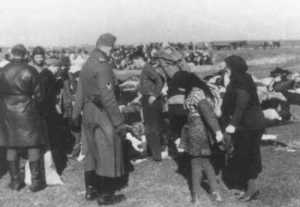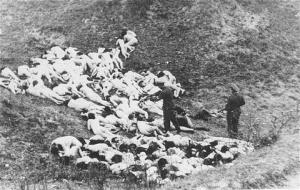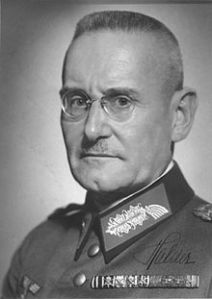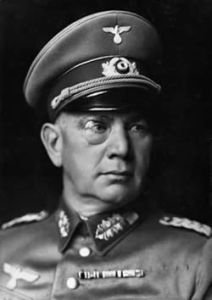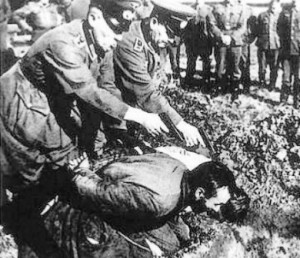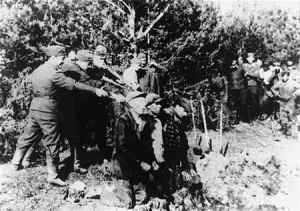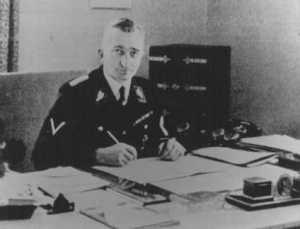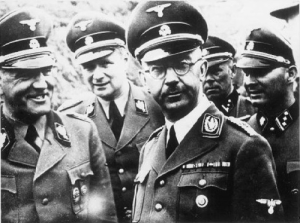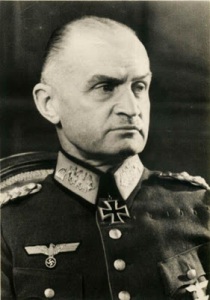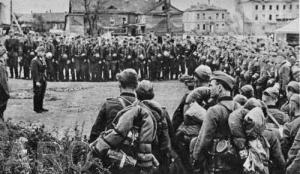Friends of Padre Steve’s World
The next installment of my article on war crimes, genocide and the role of ordinary people in them. This focuses on the legal, ideological, and military doctrine foundations of the German race war in Poland and Russia. Without these foundations it would have been difficult, maybe even impossible for the Germans to implement genocide on such a vast scale.
Peace
Padre Steve+
Wilhelm Keitel: “war was a fight for survival….dispense with outdated and traditional ideas about chivalry and the generally accepted rules of warfare…”Bundesarchiv Bild
This section of my more lengthy article about the foundations on the Holocaust my focus on the German policy of ideological-racial war in Poland and Russia. The German war against the Soviet Union and to a certain extent Poland was waged with an unforgiving ferocity against Hitler’s enemy, the Jewish-Bolshevik state and the Slavic Untermenschen.
The campaigns conducted by the German military and the SS in Poland and the Soviet Union were characterized by the rise of a “political- ideological strategy.” 25 Operation “Barbarossa showed the fusion of technocracy and ideology in the context of competitive military planning.” 26
Likewise, Hitler’s obsession with his “ideological and grandiose objectives, expressed in racial and semi-mystical terms, made the war absolute.” 27
As part of the planning Party Officials we’re appointed to oversea the various conquered regions, and SS Police Chiefs were named to assist them after the Wehrmacht moved east driving the Red Army to the outskirts of Moscow and leaving vast regions to be governed and secured from partisan activity.
Field Marshal Wilhelm Keitel took notes during a speech in March 1941 where Hitler talked about the inevitability of conflict with the Soviet Union as a being a war between “diametrically opposed ideologies” and that the “war was a fight for survival and that they dispense with their outdated and traditional ideas about chivalry and the generally accepted rules of warfare.” 28 General Halder, Chief of the OKH, or the Army General Staff in his War Dairy for that meeting noted “Annihilating verdict on Bolshevism…the leaders must demand of themselves the sacrifice of understanding their scruples.” 29 It is hard to imagine previously honorable officers who were not Nazi Party members taking such notes and not protesting against what such behavior would do to military discipline.
Based on the concepts Lebensraum and racial purity, the German approach to war would combine “racism and political ideology” for the purpose of the “conquest of new living space in the east and its ruthless Germanization.” 30 Hitler explained that the “struggle for the hegemony of the world will be decided in favor of Europe by the possession of the Russian space.” 31 Conquered territories would be “Reich protectorates…and that these areas were to be deprived of anything in the nature of a Slav intelligentsia.” 32
This goal was manifest in what is now called the “Criminal Order” issued by the OKW and signed by Keitel which stated that the war was “more than mere armed conflict; it is a collision between two different ideologies…The Bolshevist-Jewish intelligentsia must be eliminated….” 33 Other displaced inhabitants of the conquered eastern lands would be killed or allowed to starve. 34 Part of this was due to economic considerations in the Reich, which gave Germans priority in distribution of food, even that from the conquered lands. The deliberate starvation of millions was a key population control measure that supplemented other forms of annihilation. 35 As Fest noted: in Russia Hitler was “seeking nothing but “final solutions.” 36 Despite numerous post-war justifications by various Wehrmacht generals, the “Wehrmacht and army fell into line with Hitler because there was “a substantial measure of agreement of “ideological questions.”” 37
As I have already noted in the first section, Hitler’s racial ideology was central to his worldview and fundamental to understanding his actions in the war. 38
Yet no-matter how twisted and evil Hitler’s ideological formulations were, his ideas found acceptance beyond his true believers of Nazi Party faithful, to the senior ranking officers of the Army and Police, who would execute the campaigns in Poland and Russia in conjunction with the Einsatzgrüppen and Nazi party organizations. In these organizations Hitler found allies with pre-existing cultural, political and doctrinal understandings which allowed them to be willing participants in Hitler’s grand scheme of eastern conquest and genocide.
Military Doctrine and Ideology
While Hitler’s racial ideology was more extreme than many in the German military and police, these organizations had cultural beliefs and prejudices as well as doctrinal and ideological foundations which helped them become willing accomplices to Hitler and his plan for the East.
These factors were often, consciously or unconsciously, excluded from early histories of World War II. The Allies frequently relied on German officers to write these official and non-official histories at the beginning of the Cold War and to develop the “dual myth of German military brilliance and moral correctness.” 39 British historian and military theorist B.H. Liddell-Hart made the astounding statement that “one of the surprising features of the Second World War was that German Army in the field on the whole observed the rules of war than it did in 1914-1918-at any rate in fighting its western opponents….” 40
While Liddell-Hart might be excused by lack of knowledge of some German army atrocities he could not have been so ignorant of the facts. Hart interviewed almost ever senior surviving German General in Western Custody after the war, and in his history of the war he blamed the atrocities on the SS and it’s subordinate organizations. He believed the accounts of these officers which exonerated them from atrocities Hart recorded and blamed completely on the SS or other Nazi Party organization, but many of the men who he interviewed were up to their necks in many of those operations. In doing this Liddell-Hart and others presented The myth of a clean Wehrmacht as truth, when in fact it was not, something that many contemporary American, British, French and German military historians recognize. 41
These myths were helped by the trials senior and well respected German Generals such as Erich von Manstein and Albert Kesselring where “historical truth had to be sacrificed…to the demands of the Cold War.” 42 British military historian Kenneth Macksey confronted the myth that only the “Waffen SS committed barbaric and criminal acts” and wrote: “Not even the Knights of the Teutonic Order and their followers in the Middle Ages sank to the depths of the anti-Bolshevik Wehrmacht of 1941.” 43
Germany had a long running history of anti-Semitism before Hitler. German anti-Semitism often exhibited a “paranoid fear of the power of the Jews,” 44 and included a “fashionable or acceptable anti-Semitism” 45 which became more pronounced as the conditions of the Jews became better and Jews who had fled to Eastern Europe returned to Germany following the First World War. 46 Sometimes German anti-semitism was tied to religious attitudes, but more often focused on popular conspiracy theories such as in the Protocols of the Elders of Zion, writings produced by the Thüle Society, and hundred of lesser known groups.which became popular in the 1880s and 1890s and perpetrated the belief that the Jews “controlled certain aspects of life” and presented in “pseudo-scientific garb” the “myth of a secret Jewish plot for world domination which was simultaneously part of the internationalism of Freemasonry.” 47
Admiral Wilhelm Canaris provides an example as he “had grown up in the atmosphere of “moderate” anti-Semitism prevailing in the Ruhr middle class and in the Navy believed in the existence of a “Jewish problem”” and would “suggest during 1935-1936 that German Jews should be identified by a Star of David as special category citizens….” 48 Wehrmacht soldiers were “subject to daily doses of propaganda since the 1930s” and that with the “start of the Russian campaign propaganda concerning Jews became more and more aggressive.” 49 Some officers objected to Nazi actions against Jews. Then a Colonel, the later Field Marshal Erich Von Manstein protested the “Aryan paragraph” in the Reichswehr on general principal.” 50 Yet that did not stop him from issuing orders to his soldiers during Operation Barbarossa directing them to use the utmost in harshness to destroy the Jews and Soviet officials in his area of operations. Likewise, some of the men who planned and executed the most heinous crimes committed by the Nazis such as Adolf Eichmann had “no fanatical anti-Semitism or indoctrination of any kind.” 51 Men like Eichmann simply had no moral boundaries and saw their job in the SS as a job and had a need to do it well to further their personal advancement. However, Eichmann certainly became a devoted anti-semite who continued to conduct mass murders of Jews as late as 1945 long after Himmler forbade them in seeking to get the Allies to make a deal with him.
The German military under the Nazis “looked to the regime to reshape society in every respect: political, ideological, economic and military…Propaganda would hammer home absolute nature of the struggle…” 52 Ideological training began in the Hitler Youth and Reichsarbeitsdienst and prepared the future soldiers of the Reich with a firm foundation in “Anti-Semitism, anti-communism, Lebensraum – these central tenants of Nazism were all inextricably linked with the Landser’s conception of duty, with his place and role in the vast machinery of war.” 53
Following the dismissal of General Fritsch in 1938, and the resignation of General Ludwig Beck just before the proposed invasion of Czechoslovakia, General von Brauchitsch made a promise to Hitler that “he would make every effort to bring the Army closer to the State and the State’s ideology.” 54
Alfred Novotny, a Austrian soldier in the Gross Deutschland division wrote about how training depicted the Russians as Untermenschen and how they were “subjected to official rantings about how the supposedly insidious, endless influence of the Jews in practically every aspect of the enemy’s endeavors…Jews were portrayed as rats, which were overrunning the world….” 55
Nazi Party Anti-Jewish Propaganda Poster published after the beginning of the War.
This ideological component added to the already “harsh military discipline” which had a long tradition in Germany. But the Nazi ideological component aided in the conditioning of soldiers to much more severe violence and brutality towards their enemies, especially the Soviet Union, Eastern Europe, and the Balkans.
Similar programs existed in the Order Police which would play a large part in the eastern campaign, the “image of “treasonous” leftists and Jews helped shape the personal and political beliefs of many policemen throughout the interwar period.” 56 Even ordinary police training before the war in German speaking Europe “was brutalizing.” 57 These troops were recipients of an ideological formation which “aimed at shaping the worldview of the police leading to the internalization of belief along National Socialist lines.” 58 Waffen SS soldiers, especially those of the Totenkopf division were subjected by their fanatical commander Gruppenführer Theodore Eicke to even more systematic political indoctrination on the enemies of National Socialism, the Jews, freemasonry, Bolshevism and the churches. 59
Pre-Nazi German Military Development and Doctrine that Supported the Operations of the Einsatzgruppen and other “Anti-Partisan” Units of the Army, SS, and their Eastern Auxiliaries
Along with cultural anti-Semitism and the Nazification of German thought in the 1930s, there were aspects of German military doctrine developed long before the Nazis which helped prepare the way for the eastern campaign. The most important were the German Army’s anti-partisan and rear area security doctrine. The history of security anti-partisan operations dated back to the Prussian Army’s Ettapen, which began in 1813 with the Landwehr’s role in security against looters and others following Prussia’s liberation following Napoleon Bonaparte’s disastrous Russian campaign, which many German Kingdom’s supported with troops. 60 The Ettapen units supported and supplied offensive operations from the rear to the combat zone with a secondary mission of countering partisans and preventing disruptions in the rear area. The Ettapen would be reformed and regulated in 1872 following the Franco-Prussian War. 61
The German experience fighting guerrillas and partisans in the Franco-Prussian War, the francs-tireurs , “scarred the Army’s institutional mentality.” 62 Field Marshal Von Moltke the elder was “shattered,” and wrote his brother that “war was now taking on an ever more hate-inspired character.” 63 He was “appalled by improvised armies, irregular elements, and appeals to popular passion, which he described as a “return to barbarism.” 64 Von Molke, a product of traditional military training wrote: “Their gruesome work had to be answered by bloody coercion. Because of this our conduct of the war finally achieved a harshness that we deplored, but which we could not avoid.” 65
The brutal German response to the franc-tireurs found its legal justification in Franz Lieber’s principles for classification of belligerents and non-belligerents, which determined that guerrillas were outlaws or bandits. 66 Leiber’s principles were written for the Federal Army of the United States during the U.S. Civil War. Propagated as General Order 100 and signed by Abraham Lincoln the sections dealing with irregular forces and partisans dealt with this in section IV of that code:
Article 82 stated: “Men, or squads of men, who commit hostilities, whether by fighting, or inroads for destruction or plunder, or by raids of any kind, without commission, without being part and portion of the organized hostile army, and without sharing continuously in the war, but who do so with intermitting returns to their homes and avocations, or with the occasional assumption of the semblance of peaceful pursuits, divesting themselves of the character or appearance of soldiers – such men, or squads of men, are not public enemies, and, therefore, if captured, are not entitled to the privileges of prisoners of war, but shall be treated summarily as highway robbers or pirates.”
Article 84 stated: “Armed prowlers, by whatever names they may be called, or persons of the enemy’s territory, who steal within the lines of the hostile army for the purpose of robbing, killing, or of destroying bridges, roads or canals, or of robbing or destroying the mail, or of cutting the telegraph wires, are not entitled to the privileges of the prisoner of war.”
Article 85 stated: “War-rebels are persons within an occupied territory who rise in arms against the occupying or conquering army, or against the authorities established by the same. If captured, they may suffer death, whether they rise singly, in small or large bands, and whether called upon to do so by their own, but expelled, government or not. They are not prisoners of war; nor are they if discovered and secured before their conspiracy has matured to an actual rising or armed violence.” 67
The German Army adapted the Lieber Code and incorporated it in its doctrine for dealing with partisans. In response to their experience in France during the Franco-Prussian War the Germans systematically reorganized the Ettapen to include railroad and security troops, special military courts, military police, intelligence and non-military police, including the Landespolizei and the Grenzschutzpolizei. 68
The doctrinal response to partisans, or as they would become known in German writings as “bandits,” was that bandits should be encircled and destroyed. This tactic was employed in the Southwest Africa German colonies. The Germans, influenced by the experience in France, utilized that experience to organize their first, and sadly forgotten genocide. German soldiers “displayed a ferocity surpassing even that of the racially brutalized campaigns of its imperialist peers.” 69 This was hard to do in consideration of what the British were doing in South Africa, and the Sudan, and the Belgians in the Congo.
Lothar Von Trotha
The campaign against the Herero tribes which resisted the occupation of Namibia from 1904- 1912 utilized encirclement operations, racial cleansing and what would become known as Bandenkämpfung operations. 70 In 1904 the Herero were banished from their lands which were handed over to German settlers. When the Herero resisted Von Trotha ordered that they be exterminated. “Every Herero found within German borders with or without weapons, was to be shot. But most of them died without violence. The Germans simply drove them out into the desert and sealed off the border.” 71
Of about 80,000 Herero some 60,000 died in the desert, a few thousand survived to be “sentenced to hard labor in German concentration camps.” 72 Despite praise from some in the General Staff the brutality shocked many Germans and General Alfred Von Schielffen who had to defend himself from the “accusations that he had harmed the good name of the army” ensured that “Trotha never served in the field again.” 73 Despite this the application of such Bandenkämpfung operations found their way into German military doctrine.
The doctrine was further developed during the First World War, especially in the east where General Fritz Gempp described the security problem as a “ruthless struggle” in which German pacification policy “was in reality the application of terror to galvanize the population into accepting German rule.” 74
The long standing Anti-partisan doctrine was codified in the Truppenführung of 1933 which stated that “area defense against partisan warfare is the mission of all units” and that the preferred method of combating partisan bands was that they be surrounded and destroyed. 75 General Erhard Rauss later described active and passive measures used to deal with partisans, focusing on the tactic of encirclement to destroy the enemy. 76
The accounts of the German General Staff, despite Von Schieffen’s objections praised Von Trotha’s operation. “The month long sealing of desert areas, carried out with iron severity, completed the work of annihilation…the sentence had been carried out” and “the Hereros had ceased to exist as an independent people.” 77
The Nazi Anti-partisan doctrine which focused on the destruction of the partisans, was coupled a total war philosophy and provided fit well with Hitler’s radical ideology. The “propensity for brutality in anti-guerrilla warfare was complimented by officers’ growing preoccupation, both during and after World War I, with the mastery and application of violence.” 78
Michael Geyer notes: “ideological mobilization for the creation of a new national and international order increasingly defined the parameters of technocratic planning.” 79 The acceptance of long used brutal tactics to destroy the enemy combined with Hitler’s radical racial animus against the Jews could only be expected to create a maelstrom in which all international legal and moral standards would be breached.
Nazi anti-Semitic and Racial policies found an already existing military doctrine in order to carry them out.
To be continued…
Notes
25 Geyer, Michael. German Strategy 1914-1945 in Makers of Modern Strategy fromMachiavelli to the Nuclear Age.
Peter Paret, editor. Princeton University Press, Princeton NJ. 1986. p.582
26 Ibid. Geyer. German Strategy p.587
27 Strachan, Hew. European Armies and the Conduct of War. George, Allen and Unwin, London, UK 1983 p.174
28 Goerlitz, Walter. The Memoirs of Field Marshal Wilhelm Keitel: Chief of the German High Command 1938- 1945. Translated by David Irving. Cooper Square Press 2000, First English Edition 1966 William Kimber and Company Ltd. German edition published by Musterschmnidt-Verlad, Gottigen 1961 p. 135
29 Ibid. Fest, Hitler. p. 649
30 Ibid. Megargee, War of Annihilation p.7
31 Trevor-Roper, H.R. Hitler’s Table Talk 1941-1944 with an introduction by Gerhard L Weinberg, Translated by Norman Cameron and R.H. Stevens, Enigma Books, New York, NY 2000. Originally published in Great Britain by
Weidenfeld & Nicholoson, London 1953 p. 27 Goebbels notes a similar theme in his recollection of Hitler’s reasons for destroying Russia a power . See Taylor, Fred, Editor and Translator. The Goebbels Diaries 1939-1941, Penguin Books Ltd, Harmondsworth UK and New York NY 1984 pp. 413-415.
32 Goerlitz, Walter. History of the German General Staff.” Translated by Brian Battershaw, Westview Press, Boulder
and London, 1985. Originally published as Die Deutsche Generalstab Verlag der Frankfurter Hefte, Frankfur am Main, 1953 p.390
33 Warlimont, Walter. Inside Hitler’s Headquarters 1939-45. Translated by R.H. Berry, Presido Press, Novato CA,
1964 p. 150
34 Weinberg, Gerhard L. Visions of Victory: The Hopes of Eight World War II Leasers. Cambridge University Press, New York, NY 2005. p. 24
35 Aly, Gotz and Heim, Susanne. Architects of Annihilation :Auschwitz and the Logic of Destruction Phoenix
Paperbacks, London, 2003, Originally published as Vordenker der Vernichtung, Hoffman und Campe, Germany 1991, English translation by Allan Blunden. First published in Great Britain Weidenfeld & Nicholson, London, 2002 pp. 245-246
36 Ibid. Fest. Hitler p.649
37 Wette, Wolfram. The Wehrmacht: History, Myth, Reality. Translated by Deborah Lucas Schneider. Harvard University Press, Cambridge, MA 2006. Originally published as Die Wehrmacht: Feindbilder, Vernichtungskreig, Legenden. S. Fischer Verlag, GmbH, Frankfurt am Main, 2002 p.93
38 This understanding is different than many historians who as Friedlander notes advocate something like this: “The persecution and extermination of the Jews of Europe was but a secondary consequence of major German policies pursued toward entirely different goals.” See Friedlander p.xvi
39 Ibid. Megargee. War of Annihilation p.xii
40 Liddell-Hart, B.H. The German Generals Talk. Quill Publishing, New York, NY. 1979. Copyright 1948 by B.H. Liddell-Hart p.22
41 It has to be noted that Liddell-Hart published this work in 1948 and was limited in the materials available, his
primary sources being German officers who he viewed with sympathy because he saw them as exponents of his theory of the indirect approach. The time was also around the beginning of the Cold War and the Berlin Blockade when many American and British leaders were trying to end the war crimes trials and bring the West Germans into the new anti-Communist alliance.
42 Ibid. Wette. The Wehrmacht p.224
43 Macksey, Kenneth. Why the Germans Lose at War: The Myth of German Military Superiority. Barnes and Noble Books, New York 2006, originally published by Greenhill Books, 1996. p.139
44 Stern, Fritz. Gold and Iron: Bismarck, Bleichroder and Building of the German Empire. Vintage Books a division of Random House, New York 1979 First published by Alfred a Knopf 1977. p.495
45 Ibid. Stern. Gold and Iron p.494
46 Ibid. Bracher. The German Dictatorship p.34
47 Ibid. Bracher The German Dictatorship pp.34-35
48 Höhne, Heinze. Canaris: Hitler’s Master Spy. Translated by J. Maxwell, Brownjohn. Cooper Square Press,New York 1999. Originally published by C. Bertelsmann Verlag Gmbh, Munich 1976, first English edition by Doubledayand Company 1979 p. 216. Canaris would later protest the Kristalnacht to Keitel (p.334) and become convinced of the crime of the Nazis against the Jews.
49 Ibid. Witte. The Wehrmacht p.98
50 Ibid Witte The Wehrmacht, p.73
51 Arendt, Hannah, Eichmann in Jerusalem: A Report on the Banality of Evil. Revised and Enlarged Edition. Penguin Books, Harmondsworth, England and New York, NY 1965. Originally published by Viking Press, New York, NY 1963 p.26
52 Ibid. Megargee. War of Annihilation p.6
53 Fritz, Stephen G. Frontsoldaten: The German Soldier in World War II. The University Press of Kentucky, Lexington, KY 1995 p.195
54 Craig, Gordon A. The Politics of the Prussian Army 1640-1945. Oxford University Press, London and New York, 1955 p.495
55 Novatny, Alfred. The Good Soldier. The Aberjona Press, Bedford, PA 2003 p.40
56 Westermann, Edward B. Hitler’s Police Battalions: Enforcing Racial War in the East. University Press of Kansas, Lawrence, KS. 2005 p.64 Westermann also notes the preponderance of SA men who entered the Order Police in the 1930s, a factor which helped further the politicization of that organization.
57 Ibid. Rhodes Masters of Death p.23
58 Ibid. Westermann Hitler’s Police Battalions p.103
59 Sydnor, Charles W. Soldiers of Destruction: The SS Death’s Head Division, 1933-1945. Princeton University Press, Princeton, NY 1977 p. 28
60 Shepherd, Ben. War in the Wild East: The German Army and Soviet Partisans. Harvard University Press, Cambridge, MA 2004 p.41
61 Blood, Philip. Hitler’s Bandit Hunters: The SS and the Occupation of Europe. Potomac Books Inc. Washington, DC 2008 p.11
62 Ibid. Shepherd. War in the Wild East p.42
63 Ibid. Goerlitz. History of the German General Staff p.93
64 Rothenburg, Gunther. Moltke, Schieffen, and the Doctrine of Strategic Envelopment in Makers of ModernStrategy from Machiavelli to the Nuclear Age. Peter Paret, editor. Princeton University Press, Princeton NJ. 1986 p.305
65 Hughes, Daniel J. editor. Moltke on the Art of War: Selected Writings, translated by Harry Bell and Daniel J Hughes. Presidio Press, Novato CA 1993. p.32
66 Ibid. Blood Hitler’s Bandit Hunters p.6 Lieber was a Prussian emigrant to the US who taught law at Columbia University.
67 Instructions for the Government of Armies of the United States in the Field, prepared by Francis Lieber, LL.D., Originally Issued as General Orders No. 100, Adjutant General’s Office, 1863, Washington 1898: Government Printing Office. Retrieved from http://avalon.law.yale.edu/19th_century/lieber.asp 6 May 2014
68 Ibid. Blood Hitler’s Bandit Hunters pp.12-13
69 Ibid. Shepherd Wild War in the East p.42
70 Ibid. Blood. Hitler’s Bandit Hunters pp.16-19 71 Ibid. Lindqvist Exterminate theBrutes p.149 72 Ibid. Lindqvist Exterminate the Brutes p.149 73 Ibid. Blood. Hitler’sBandit Hunters p.19
74 Ibid. Blood. Hitler’s Bandit Hunters p.22
75 Condell, Bruce and Zabecki, David T. Editors. On the German Art of War: Truppenführung, Lynn Rienner Publishers, Boulder CO and London 2001. p.172
76 Tsouras, Peter G. Editor, Fighting in Hell: The German Ordeal on the Eastern Front The Ballantine Publishing
Group, New York, 1998. First published 1995 by Greenhill Books pp. 142-146. It is interesting to note that Rauss does not describe any actual anti-partisan operation
77 Ibid. Lindqvist. P.149
78 Ibid. Shepherd. War in the Wild East p.45
79 Ibid. Geyer. German Strategy p.58








